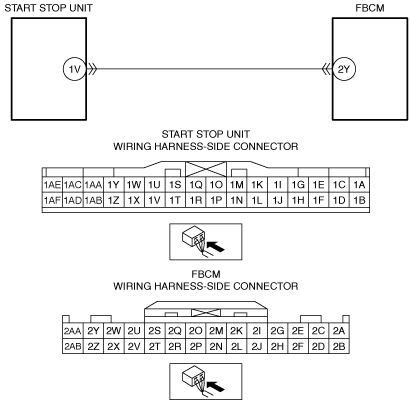|
1
|
INSPECT IF MALFUNCTION CAUSE IS START STOP UNIT OR FRONT BODY CONTROL MODULE (FBCM)
• Display the start stop unit PID WIP_F_LOW using the M-MDS.
• Verify the PID while operating the windshield wiper switch.
• Is the PID displayed normally?
|
Yes
|
Go to Step 3.
|
|
No
|
Go to the next step.
|
|
2
|
INSPECT WINDSHIELD WIPER SWITCH
• Inspect the windshield wiper switch.
• Is the windshield wiper switch normal?
|
Yes
|
Replace the start stop unit, then go to Step 7.
|
|
No
|
Replace the wiper and washer switch, then go to Step 7.
|
|
3
|
INSPECT IF MALFUNCTION CAUSE IS FRONT BODY CONTROL MODULE (FBCM) OR WIRING HARNESS
• Display the front body control module (FBCM) PID WIP_F using the M-MDS.
• Verify the PID while operating the windshield wiper switch.
• Is the PID displayed normally?
|
Yes
|
Go to the next step.
|
|
No
|
Perform the CAN malfunction diagnosis flow and inspect the CAN for a malfunction.
• If there is no malfunction in the CAN, replace the front body control module (FBCM), then go to Step 7.
|
|
4
|
INSPECT FOR SHORT TO GROUND IN WIRING HARNESS BETWEEN START STOP UNIT AND FRONT BODY CONTROL MODULE (FBCM)
• Switch the ignition off.
• Disconnect the negative battery cable.
• Disconnect the front body control module (FBCM) connector.
• Disconnect the start stop unit connector.
• Inspect for continuity between front body control module (FBCM) terminal 2Y (wiring harness-side) and body ground.
• Is there continuity?
|
Yes
|
Refer to the wiring diagram and verify whether or not there is a common connector between start stop unit terminal 1V and front body control module (FBCM) terminal 2Y.
If there is a common connector:
• Determine the malfunctioning part by inspecting the common connector and the terminal for corrosion, damage, or pin disconnection, and the common wiring harness for a short to ground.
• Repair or replace the malfunctioning part.
If there is no common connector:
• Repair or replace the wiring harness which has a short to ground.
Go to Step 7.
|
|
No
|
Go to the next step.
|
|
5
|
INSPECT FOR SHORT TO POWER SUPPLY IN WIRING HARNESS BETWEEN START STOP UNIT AND FRONT BODY CONTROL MODULE (FBCM)
• Verify that the front body control module (FBCM) and start stop unit connectors are disconnected.
• Reconnect the negative battery cable.
• Switch the ignition ON (engine off or on).
• Measure the voltage at the front body control module (FBCM) terminal 2Y (wiring harness-side).
• Is the voltage 0 V?
|
Yes
|
Go to the next step.
|
|
No
|
Refer to the wiring diagram and verify whether or not there is a common connector between start stop unit terminal 1V and front body control module (FBCM) terminal 2Y.
If there is a common connector:
• Determine the malfunctioning part by inspecting the common connector and the terminal for corrosion, damage, or pin disconnection, and the common wiring harness for a short to power supply.
• Repair or replace the malfunctioning part.
If there is no common connector:
• Repair or replace the wiring harness which has a short to power supply.
Go to Step 7.
|
|
6
|
INSPECT FOR OPEN CIRCUIT IN WIRING HARNESS BETWEEN START STOP UNIT AND FRONT BODY CONTROL MODULE (FBCM)
• Verify that the front body control module (FBCM) and start stop unit connectors are disconnected.
• Switch the ignition off.
• Disconnect the negative battery cable.
• Inspect for continuity between start stop unit terminal 1V (wiring harness-side) and front body control module (FBCM) terminal 2Y (wiring harness-side).
• Is there continuity?
|
Yes
|
Go to the next step.
|
|
No
|
Refer to the wiring diagram and verify whether or not there is a common connector between start stop unit terminal 1V and front body control module (FBCM) terminal 2Y.
If there is a common connector:
• Determine the malfunctioning part by inspecting the common connector and the terminal for corrosion, damage, or pin disconnection, and the common wiring harness for an open circuit.
• Repair or replace the malfunctioning part.
If there is no common connector:
• Repair or replace the wiring harness which has an open circuit.
Go to the next step.
|
|
7
|
VERIFY THAT REPAIRS HAVE BEEN COMPLETED
• Always reconnect all disconnected connectors.
• Reconnect the negative battery cable.
• Clear the front body control module (FBCM) DTCs using the M-MDS.
• Switch the ignition ON (engine off or on) and wait for 5 s or more.
• Retrieve the front body control module (FBCM) DTCs using the M-MDS.
• Is the same DTC displayed?
|
Yes
|
Repeat the inspection from Step 1.
• If the malfunction recurs, replace the front body control module (FBCM).
Go to the next step.
|
|
No
|
Go to the next step.
|
|
8
|
VERIFY IF OTHER DTCs DISPLAYED
• Are any other DTCs displayed?
|
Yes
|
Repair or replace the malfunctioning part according to the applicable DTC troubleshooting.
|
|
No
|
DTC troubleshooting completed.
|
